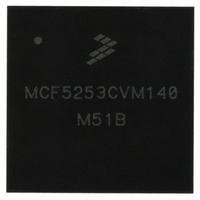MCF5253CVM140 Freescale Semiconductor, MCF5253CVM140 Datasheet - Page 572

MCF5253CVM140
Manufacturer Part Number
MCF5253CVM140
Description
IC MPU 32BIT 140MHZ 225-MAPBGA
Manufacturer
Freescale Semiconductor
Series
MCF525xr
Datasheets
1.MCF5253VM140J.pdf
(34 pages)
2.MCF5253VM140J.pdf
(8 pages)
3.MCF5253VM140J.pdf
(648 pages)
4.MCF5253VM140J.pdf
(2 pages)
Specifications of MCF5253CVM140
Core Processor
Coldfire V2
Core Size
32-Bit
Speed
140MHz
Connectivity
CAN, EBI/EMI, I²C, QSPI, UART/USART, USB OTG
Peripherals
DMA, WDT
Program Memory Type
ROMless
Ram Size
128K x 8
Voltage - Supply (vcc/vdd)
1.08 V ~ 1.32 V
Data Converters
A/D 6x12b
Oscillator Type
External
Operating Temperature
-40°C ~ 85°C
Package / Case
225-MAPBGA
Family Name
MCF5xxx
Device Core
ColdFire V2
Device Core Size
32b
Frequency (max)
140MHz
Instruction Set Architecture
RISC
Supply Voltage 1 (typ)
1.2/3.3V
Operating Supply Voltage (max)
1.32/3.6V
Operating Supply Voltage (min)
1.08/3V
Operating Temp Range
-40C to 85C
Operating Temperature Classification
Industrial
Mounting
Surface Mount
Pin Count
225
Package Type
MA-BGA
Lead Free Status / RoHS Status
Lead free / RoHS Compliant
Number Of I /o
-
Eeprom Size
-
Program Memory Size
-
Lead Free Status / Rohs Status
Compliant
Available stocks
Company
Part Number
Manufacturer
Quantity
Price
Company:
Part Number:
MCF5253CVM140
Manufacturer:
FREESCALE
Quantity:
300
Company:
Part Number:
MCF5253CVM140
Manufacturer:
Freescale Semiconductor
Quantity:
10 000
Part Number:
MCF5253CVM140
Manufacturer:
FREESCALE
Quantity:
20 000
Company:
Part Number:
MCF5253CVM140J
Manufacturer:
Freescale Semiconductor
Quantity:
10 000
- MCF5253VM140J PDF datasheet
- MCF5253VM140J PDF datasheet #2
- MCF5253VM140J PDF datasheet #3
- MCF5253VM140J PDF datasheet #4
- Current page: 572 of 648
- Download datasheet (8Mb)
Universal Serial Bus Interface
By definition, the host controller cannot reach an siTD at the wrong time. If the I/O field indicates an IN,
then the start-split transaction includes only the extended token plus the full-speed token. The software
must initialize the siTD[Total Bytes To Transfer] field to the number of bytes expected. This is usually the
maximum packet size for the full-speed endpoint. The host controller exits this state when the start-split
transaction is complete.
The remainder of this section is specific to an isochronous OUT endpoint (that is, the I/O field indicates
an OUT). When the host controller executes a start-split transaction for an isochronous OUT it includes a
data payload in the start-split transaction. The memory buffer address for the data payload is constructed
by concatenating siTD[Current Offset] with the page pointer indicated by the page select field (siTD[P]).
A zero in this field selects Page 0 and a 1 selects Page 1. During the start-split for an OUT, if the data
transfer crosses a page boundary during the transaction, the host controller must detect the page cross,
update the siTD[P] bit from a zero to a one, and begin using the siTD Page 1 with siTD[Current Offset] as
the memory address pointer. The field siTD[TP] is used to annotate each start-split transaction with the
indication of which part of the split-transaction data the current payload represents (ALL, BEGIN, MID,
END). In all cases, the host controller simply uses the value in siTD[TP] to mark the start-split with the
correct transaction position code.
T-Count is always initialized to the number of start-splits for the current frame. TP is always initialized to
the first required transaction position identifier. The scheduling boundary case (see
to determine the initial value of TP. The initial cases are summarized in
After each start-split transaction is complete, the host controller updates T-Count and TP appropriately so
that the next start-split is correctly annotated.
which must be accomplished by the host controller.
24-110
Case
1, 2a
1, 2a
BEGIN
BEGIN
MID
MID
ALL
TP
T-count
!=1
=1
T-count
Next
!=1
!=1
Table 24-69. Transaction Position (TP)/Transaction Count (T-Count) Transition
0
1
1
Table 24-68. Initial Conditions for OUT siTD's TP and T-Count Fields
BEGIN
ALL
TP
TP Next
END
END
MID
MID
N/A
When the OUT data payload is less than (or equal to) 188 bytes, only one start-split is
required to move the data. The one start-split must be marked with an ALL.
When the OUT data payload is greater than 188 bytes more than one start-split must be
used to move the data. The initial start-split must be marked with a BEGIN.
Transition from ALL, to done.
Transition from BEGIN to END. Occurs when T-count starts at 2.
Transition from BEGIN to MID. Occurs when T-count starts at greater than 2.
TP stays at MID while T-count is not equal to 1 (for example, greater than 1). This case
can occur for any of the scheduling boundary cases where the T-count starts greater
than 3.
Transition from MID to END. This case can occur for any of the scheduling boundary
cases where the T-count starts greater than 2.
MCF5253 Reference Manual, Rev. 1
Table 24-69
illustrates all of the TP and T-count transitions,
Description
Description
Table
24-68.
Figure
Freescale Semiconductor
24-58) is used
Related parts for MCF5253CVM140
Image
Part Number
Description
Manufacturer
Datasheet
Request
R
Part Number:
Description:
Mcf5253 Coldfire? Microprocessor Data Sheet
Manufacturer:
Freescale Semiconductor, Inc
Datasheet:
Part Number:
Description:
Manufacturer:
Freescale Semiconductor, Inc
Datasheet:
Part Number:
Description:
Manufacturer:
Freescale Semiconductor, Inc
Datasheet:
Part Number:
Description:
Manufacturer:
Freescale Semiconductor, Inc
Datasheet:
Part Number:
Description:
Manufacturer:
Freescale Semiconductor, Inc
Datasheet:
Part Number:
Description:
Manufacturer:
Freescale Semiconductor, Inc
Datasheet:
Part Number:
Description:
Manufacturer:
Freescale Semiconductor, Inc
Datasheet:
Part Number:
Description:
Manufacturer:
Freescale Semiconductor, Inc
Datasheet:
Part Number:
Description:
Manufacturer:
Freescale Semiconductor, Inc
Datasheet:
Part Number:
Description:
Manufacturer:
Freescale Semiconductor, Inc
Datasheet:
Part Number:
Description:
Manufacturer:
Freescale Semiconductor, Inc
Datasheet:
Part Number:
Description:
Manufacturer:
Freescale Semiconductor, Inc
Datasheet:
Part Number:
Description:
Manufacturer:
Freescale Semiconductor, Inc
Datasheet:
Part Number:
Description:
Manufacturer:
Freescale Semiconductor, Inc
Datasheet:
Part Number:
Description:
Manufacturer:
Freescale Semiconductor, Inc
Datasheet:











